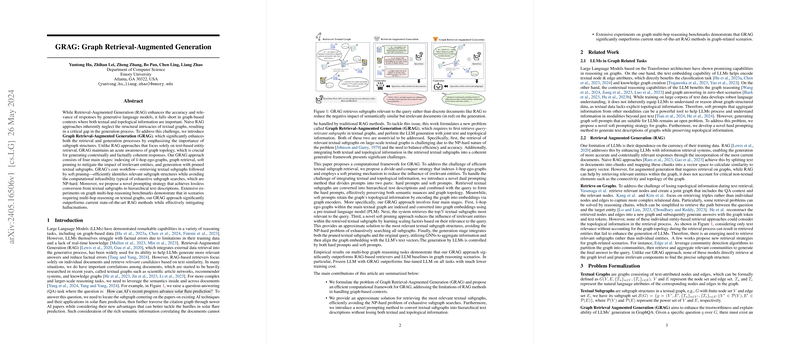GRAG: Graph Retrieval-Augmented Generation
The paper presents "Graph Retrieval-Augmented Generation (GRAG)," a novel framework designed to improve the efficacy of Retrieval-Augmented Generation (RAG) methods when dealing with graph-based contexts. Traditional RAG approaches, while effective in enhancing the relevance and accuracy of generative LLMs, fall short in scenarios where both textual and topological information are critical. The GRAG framework addresses these limitations by introducing a mechanism to retrieve and utilize textual subgraphs, thus preserving the rich structural information essential for generating factually coherent responses.
Methodology
The GRAG framework consists of four main stages: textual subgraph retrieval, soft pruning, and generation with pruned textual subgraphs. Each of these components plays a critical role in ensuring that the generative process benefits from both the textual and topological information inherent in the graph data.
- Textual Subgraph Retrieval: GRAG initiates the retrieval process by indexing -hop ego-graphs. This indexing is accomplished using a pre-trained LLM (PLM) to convert textual attributes of nodes and edges into embeddings. The goal is to retrieve the most relevant -hop ego-graphs based on the similarity between the question embedding and graph embeddings. Rather than a naive entity retrieval, this method ensures that the structural context is preserved, providing a richer pool of information for generating responses.
- Soft Pruning: Once the relevant subgraphs are retrieved, a soft pruning mechanism is employed to reduce the impact of irrelevant entities. This is achieved by scaling node and edge attributes based on their relevance to the query. The soft pruning mechanism uses learned scaling factors to diminish the influence of non-contributing elements, thereby refining the subgraph to retain only the most pertinent information.
- Graph-Aware Generation: The final stage involves the generation of responses using both soft and hard prompts. GRAG introduces a novel dual prompting method where soft prompts retain topological information through graph embeddings, and hard prompts preserve textual nuances by converting the textual subgraph into hierarchical text descriptions. This structured approach ensures that the generation process benefits from the full spectrum of graph information, including both semantics and structure.
Results
Extensive experiments on multi-hop graph reasoning benchmarks such as the {\fontfamily{pcr}\selectfont WebQSP} and {\fontfamily{pcr}\selectfont Explagraphs} datasets demonstrate that GRAG significantly outperforms existing state-of-the-art RAG methods. Key performance metrics such as Hit@1, Score, Recall, and Accuracy were used to evaluate the efficacy of GRAG.
Key Highlights:
- Hit@1 Performance: GRAG achieved a Hit@1 score of 0.7236 on the {\fontfamily{pcr}\selectfont WebQSP} dataset, outperforming the nearest competitor, G-Retriever, which scored 0.6808.
- Score and Recall: On the same dataset, GRAG's Score and Recall stood at 0.5022 and 0.5099, respectively, illustrating its superior retrieval and generation capabilities.
- Accuracy on {\fontfamily{pcr}\selectfont Explagraphs}: GRAG's accuracy was 0.9223, far surpassing the baseline figures, thus highlighting its effectiveness even in smaller, more reasoning-intensive datasets.
Implications and Future Developments
The implications of GRAG are far-reaching, both practically and theoretically. Practically, GRAG's ability to integrate both textual and topological information into the generative process significantly enhances the factual accuracy and contextual relevance of LLMs, making them more reliable for complex query-answering tasks. This can be particularly beneficial in domains such as scientific research, recommender systems, and expert systems where graph-based data structures are prevalent.
Theoretically, GRAG opens new avenues for research in the intersection of graph theory and natural language processing. Future developments could focus on further optimizing the retrieval and pruning stages, possibly through more advanced machine learning techniques or hybrid models. Additionally, exploring the scalability of GRAG to even larger graphs and its adaptability to other graph-based tasks, such as graph-based sentiment analysis or entity resolution in knowledge graphs, could lead to groundbreaking advancements in the field.
In summary, GRAG represents a significant step forward in retrieval-augmented generation, particularly for graph-based contexts. Its innovative approach to integrating textual and topological information addresses critical gaps in current RAG methods, setting a new benchmark for future research and applications in this domain.
